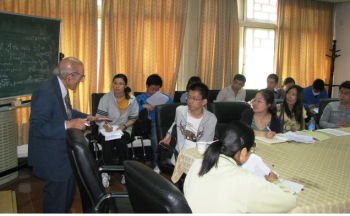Peking University, May 18, 2011: Almost two millennia after the language first came to China through Buddhist scriptures, a renewed interest in Buddhist studies and recent discoveries of long-forgotten manuscripts in Tibet have sparked a revival of the study of the ancient language among Chinese scholars.
Peking University has launched an ambitious program to train more than 60 Chinese students in Sanskrit, with the hope of creating a team of researchers to help translate hundreds of manuscripts containing scriptures that were found in China's centers of Buddhism, such as Tibet and Hangzhou.

Renowned Sanskrit scholar Satyavrat Shastri teaching Sanskrit to Chinese students at PKU
PKU students chanting verses at a class led by Satyavrat Shastri (Video via TheHindu.com)
Manuscript collection
“There is a rich manuscript collection in Tibet, particularly. Many of the originals have not been recovered, and are only available in Chinese and Tibetan, so it is important for us to find a way to render them back into Sanskrit,” said Satyavrat Shastri, a renowned New Delhi-based Sanskrit scholar and poet, who is in Beijing this week as a visiting lecturer to meet students and teachers at PKU.
“What they are trying to do here is invaluable, and they are making great progress,” Shastri said, adding that he was pleasantly surprised by the students' technical level. “I was struck by the interest, of both teachers and scholars, in little details, such as getting the pronunciation perfect. They recited the Bhagavad Gita with me, and it was a unique experience. The pronunciation, the metre [of reciting the verses], was remarkable.”
The Sanskrit program at PKU has a long history, set up in the 1960s and subsequently expanded by renowned Indologist Ji Xianlin, who translated dozens of works and is seen by many here as single-handedly introducing classical Indian culture to a whole generation of Chinese. Today, the program aims to carry forward the legacy of Ji, who passed away in July 2009.
The university's efforts received a boost in 2005, when it was given support by the Ministry of Education to expand admissions, part of an effort to boost the manuscript research. Now, for the first time, the program has a regular annual intake of students at both undergraduate and post-graduate levels, currently training between 50 and 60 students. “We want to continue what Ji Xianlin started,” said Duan Qing, a professor in Sanskrit and Pali, who was once trained under Ji. “Our program is quite mature now, and is the only complete Sanskrit program in China.” She attributed the recent boost in funding to increasing government support for the humanities, ignored during the People's Republic's first three decades, when the country's focus was on development alone. “Sanskrit research is being viewed with importance now,” she said. “India and China were culturally connected. I don't think there's another country in the world where so many Sanskrit works were translated into another language, and this has been going on for over 1,000 years.”
Duan heads the Research Institute of Sanskrit Manuscripts and Buddhist Literature at Peking University, which is working with regional governments and hoping to create an archive for lost manuscripts and palm-leaves. Peking University has also begun working with Sanskrit programs in universities in the West, particularly in Germany, to improve both teaching methods and archiving practices. Indian universities, however, appeared to show little interest in taking forward cooperation.
Shastri, who is an honorary professor at the Jawaharlal Nehru University, admitted there was “precious little” cooperation between the two countries. There was room for much more, he said, encouraged by the positive response to his teaching methods this past week. “We want to learn Sanskrit through traditional methods,” one teacher told him. “Not from the West.”
Reported by: Ananth Krishnan
Edited by: Jacques
Source: The Hindu